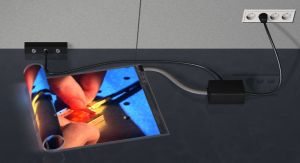Mobile phones, flat screens or illumination systems – organic light-emitting diodes will be applied to an increasing extent in the future and open up new design and function options. Scientists of the KIT Institute of Nanotechnology (INT) have now developed a simulation method for the low-cost optimization of OLEDs within shorter time. By means of SiMoNa, material properties can be improved specifically and appropriate dye molecules can be designed and patented. The NanoMatch startup will be established this month.
OLEDs are already used in the displays of mobile phones. In the future, multilayered organic light-emitting diodes are expected to replace conventional technologies in other illumination applications as well. As they are ultraflat, ultralight, and highly energy-efficient, they open up completely new options, including rolling screens on moldable carrier materials. If such technologies are to be highly efficient and available at low costs, the OLEDs will have to be optimized prior to production. So far, numerous experiments have been needed for this purpose as well as in many other fields of organic electronics.
Researchers of the team directed by Professor Dr. Wolfgang Wenzel and Professor Dr. Mario Ruben from the Institute of Nanotechnology and by Dr. Robert Maul from the Institute for Theoretical Solid-State Physics (TFP) of KIT have now developed intelligent software to simulate molecular processes in an OLED on the computer. Using SiMoNa, electronic properties and performance characteristics of OLEDs can be optimized at low costs within a shorter period of time.
In May 2011, NanoMatch (www.nanomatch.de), a startup of KIT, will take up operation with the support of the KIT Innovation Management Service Unit (IMA), the Center for Innovation and Entrepreneurship (CIE) of KIT, and the nanovalley.eu initiative. NanoMatch will adapt and apply this novel simulation technology developed by KIT.
SiMoNa stands for “Simulation of Molecular Nanostructures”. For the first time, this method combines the structural prognosis of the material on a molecular basis with a quantum mechanics analysis of the resulting function. Compared to conventional approaches to determining the morphology, simulation speed is increased by a factor of about a million. Based on the three-dimensional structure of the system obtained, the mobility of charge carriers can be predicted by means of quantum mechanics calculations.
The new software can simulate highly specific material compositions and predict charge transfer also in unknown substance classes for which experimental data are still lacking. Hence, SiMoNa is suited for the design and early patenting of specific components for OLEDs and the optimization of known OLED components in terms of functioning and performance.
From virtual optimization, the developers derive major parameters for prototypes of organic light-emitting diodes. These data are used as a basis of special chemicals and basic substances of OLEDs tailored to novel applications. The advantages of SiMoNa are the simulation-based shortening of OLED development cycles and earlier commercialization based on these simulation results.
Further information can be found at: http://www.nanomatch.de/.
A short film is available at: KIT LINK
In close partnership with society, KIT develops solutions for urgent challenges – from climate change, energy transition and sustainable use of natural resources to artificial intelligence, sovereignty and an aging population. As The University in the Helmholtz Association, KIT unites scientific excellence from insight to application-driven research under one roof – and is thus in a unique position to drive this transformation. As a University of Excellence, KIT offers its more than 10,000 employees and 22,800 students outstanding opportunities to shape a sustainable and resilient future. KIT – Science for Impact.

